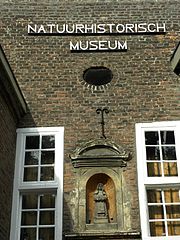Maastricht Natural History Museum
Natuurhistorisch Museum Maastricht | |
 Front of the museum in 2010 | |
 | |
| Location | De Bosquetplein 7[1] Maastricht, Netherlands |
|---|---|
| Coordinates | 50°50′42″N 5°41′16″E / 50.8449°N 5.6878°E |
| Type | Natural history museum |
| Visitors | 28,614 (2013)[2] |
| Director | Stef Niekamp[3] |
| Website | nhmmaastricht |
Maastricht Natural History Museum (Dutch: Natuurhistorisch Museum Maastricht) is a museum of natural history in Maastricht, Netherlands. The museum is located in a former monastery called Grauwzustersklooster (English: Monastery of the Grey Sisters) in the historic district Jekerkwartier in the centre of Maastricht.
The collection is dedicated to the geology, paleontology, flora and fauna of South Limburg. Highlights from the collection are Cretaceous fossils from Sint-Pietersberg, most notably the skull of a Mosasaur (nicknamed "Bèr") and specimens of Hoffmann's giant turtle, Allopleuron hofmanni and Suyckerbuyk's turtle, Glyptochelone suyckerbuyki.
A significant mosasaurus skull was taken by the French during the Siege of Maastricht, and has been housed at the French National Museum of Natural History since 1794. Multiple attempts have been made since 1824 to have the piece returned to Maastricht.[4]
The museum also has a period room with cabinets of curiosities. A remarkable piece from that collection is a rat king from the 19th century.
Behind the museum is a botanical garden, situated on the banks of the small river Jeker.

References
[edit]- ^ "Hoe kom ik er?" (in Dutch), Maastricht Natural History Museum. Retrieved 6 October 2017.
- ^ "Integraal jaarverslag van Centre Céramique, Kumulus en Natuurhistorisch Museum Maastricht over 2013" (in Dutch), Centre Céramique/ISSUU, 2014. Retrieved 6 October 2017.
- ^ "Wie is wie?" (in Dutch), Maastricht Natural History Museum. Retrieved 6 October 2017.
- ^ Heingartner, Douglas (2023-12-07). "The Netherlands Wants France to Return a Mosasaurus Fossil They Seized in 1794". SuchDinosaurs. Retrieved 2023-12-11.
External links
[edit]- Official website
 Media related to Natural History Museum of Maastricht at Wikimedia Commons
Media related to Natural History Museum of Maastricht at Wikimedia Commons
